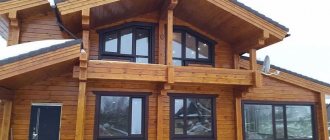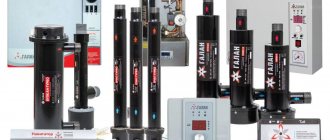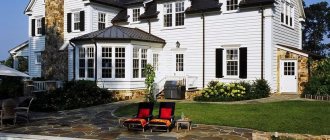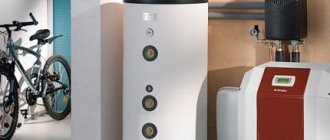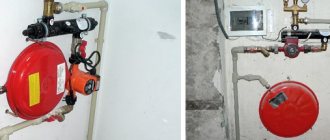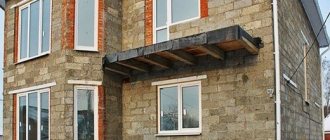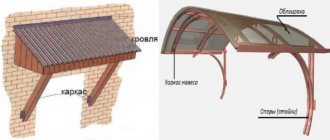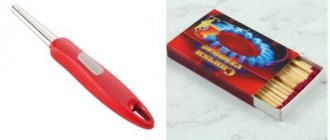Siding is one of the most commonly used facade materials, which has only strengthened its position recently. Vinyl is the most popular - due to the fact that it is both pleasing to the eye, has good characteristics and is sold at a reasonable price. But recently a new type began to crowd it out - foam siding. Many people still don’t know about its features, but it is very promising, so it’s worth taking a closer look at it. We talk about the characteristics, advantages and disadvantages of foam siding, its application, and consider reviews from builders.
About the material
Siding is a tracing paper of the English word; the translation means “outer cladding” and clearly indicates the purpose of the material. Siding is the outer part of a suspended facade system, which is also called ventilated.
Ventilated facade made of siding: warm walls - a comfortable home Source dom-steny.ru
Appearance
Siding is called panels (planks) of an elongated shape, with a perforated edge and a latch that allows you to connect them into sections of the required size. There are several types of component strips:
- Basic (ordinary).
- Auxiliary. There are initial, finishing and connecting strips.
- Soffit panels. Ceiling panels for roof lining.
- Trims for window and door openings.
- Edging. Connect the corners of the siding panels, covering the ends.
Panels of various textures are available for sale, and the colors of the siding for cladding the house allow you to realize your vision of a beautiful home. Popular are panels with a surface that imitates wood (timber, block house, lining), natural stone, plaster, and brick.
About the principle of arranging a curtain wall system
The hanging system is installed in several stages:
- Installation of sheathing (guides). Wooden slats or a metal profile are used as lathing for wooden walls; the wooden sheathing is pre-treated with a protective compound. The sheathing is made vertical for horizontal panels, and vice versa. The role of the sheathing is to maintain the air gap between the wall and the siding.
- Waterproofing. This must be done using a moisture-windproof membrane.
Accessories for siding Source polvam.ru
- Insulation. If thermal protection is needed, the lathing is made in two layers, between which insulation is placed.
- Installation of panels.
This design of the façade system allows air to circulate freely along the walls, preventing condensation from forming on the wood. Constant ventilation protects the walls from mold and mildew, and the system as a whole from external influences (sun, rain and frost). In addition to protective, siding has another important function - decorative.
Price
The production of foam siding is a technologically labor-intensive process that requires an increased amount of raw materials. This makes the material several times more expensive than traditional siding. In addition, it is still poorly represented in construction and finishing stores - it is too unprofitable to transport panels from Europe for piece demand, and in Russia only one company produces it. The closest competitor is Poland.
The price for one standard panel is from 450 to 800 rubles, depending on the region of purchase, the seller and the popularity of the color. On average, a square meter of foam siding will cost approximately 800-1500 rubles without calculating additional costs.
Features of the use of siding in the cladding of wooden housing
Wooden buildings attract with their spectacular, natural appearance, the preservation of which is a difficult task. The installation of external cladding helps protect wooden walls from destructive dampness and mold.
The most common material for covering a wooden building is vinyl siding. The most in demand are products in pastel colors (as they are the least fading) and with imitation of natural materials. Professionally installed siding can significantly extend the life of your home. It is more practical to use a galvanized profile as a frame, which is not prone to corrosion and deformation.
Installation process of vinyl siding with waterproofing Source orgtorg.org
What is Alta-Board foam siding from the Alta-Profil company
Alta-Board foam siding: this is the latest facade cladding material for private homes and commercial buildings. Consists of two layers: top and bottom layer. The upper outer one has the appearance of a classic board and has a protective and decorative function. It consists of acrylic, pigments, modifiers and other special components developed with German specialists to ensure almost absolute color fastness. Siding accurately reproduces the appearance of natural wood. The surface is textured and the texture depth is 1.5-2 mm. The bottom layer is the main one, and is based on foamed PVC (polyvinyl chloride*). Foamed PVC absorbs vibration, provides impact resistance, heat and sound insulation, and light weight of the siding panel. Alta-Bod foam siding is available in a length of three meters and a width (total) of two hundred and seventeen millimeters. The thickness of the Alta Board siding panel is 14 mm; for reference, vinyl siding is 1.1 mm thick maximum.
Go to the foam siding section >>
Types of material for exterior finishing: advantages and features
Siding is in consistently high demand due to its low cost and versatility. The panels easily solve several problems - decorating, protecting and insulating the structure. The first siding panels (which appeared in the 19th century) were wooden. Modern manufacturers offer a choice of siding for cladding a house in a wide color palette, made from different materials:
Vinyl
More than half of buyers choose vinyl siding due to its characteristics:
- Cheapness.
- Easy installation (lightweight building material) and subsequent maintenance.
- Heat resistance. The material is designed for a range from -50 to +50°C; it does not burn in fire, but melts.
- Weather resistant. Excellent protection from wind, rain and snow.
- Wide palette of colors.
High-quality vinyl siding is a popular material for external cladding Source yandex.ru
Disadvantages include:
- Lifetime. Not as durable as other materials; fades over time in the sun (white - turns yellow).
- Subtleties of installation. The panels react to changes in temperature by expanding or contracting. During installation, take this into account, leaving gaps and not fastening the panels too tightly (otherwise the siding may ripple or burst).
Acrylic
When choosing which siding is best for cladding a house, you should pay attention to acrylic. This type of cladding panel with a high-strength sandwich structure was developed later than vinyl; thanks to technology, panels of dark, rich colors appeared. Acrylic products are in constant demand due to the following advantages:
- Resistance to solar radiation. 10 times higher than vinyl panels.
- Strength. It does not deform over time (withstands from -50 to +80°C), and does not cause play at the attachment points.
- Practicality. Easy installation and further maintenance.
The main disadvantage of acrylic panels is the high price. If you are tempted by cheap panels, most likely these are products made in violation of technology or from low-quality materials; In the future, you should expect cracking or color changes from such a coating. A quality certificate from the seller will help avoid such a problem.
Acrylic siding is highly resistant to ultraviolet light Source smogem-sami.ru
See also: Catalog of companies that specialize in finishing materials.
Metal
High-quality metal siding for cladding a house consists of several layers. The base is a steel sheet protected with zinc, anti-corrosion coating and primer. A layer of polymer is applied to the front surface, paint or varnish is applied to the back surface. Thanks to this structure, the profile has excellent performance properties:
- Life time. The average age ranges from 25 to 40 years. The panels retain their original color for 10-15 years.
- Strength. The metal coating is resistant to temperature changes, deformation, shock, fire and precipitation.
- Variety of colors.
The disadvantages are:
- High price.
- Weight. Makes installation and repair difficult.
- Low thermal insulation.
- Tendency to corrosion in places of chips and scratches.
Fiber cement
Fiber-cement (fiber-reinforced concrete) siding is increasingly used when arranging the facades of country houses. Fiber cement panels contain cement, sand, mineral fillers (natural or synthetic) and reinforcing fibers. On the front side there is a layer with the texture of wood or stone.
Fiber cement siding does not have interlocking joints; installation is carried out with overlap Source dom-steny.ru
The positive properties of the material are:
- Long service life. Considered the most durable.
- Wear resistance. The material is used in all climatic zones.
- Durability, dimensional stability and environmental friendliness.
- Good sound insulation.
- Easy image change. You can easily change the boring color of fiber cement coating by simply repainting it.
The disadvantages include:
- Weight. Fiber cement panels weigh more than metal and polymer panels; the sheathing must be strong.
- Fragility. Care is required during transportation and installation.
Ceramic
Ceramic siding is a type of fiber cement material. The Japanese came up with the idea of adding clay to the fiber cement composition or making the front coating ceramic. Ceramic siding has valuable qualities:
- Fire resistance. The property is complemented by ultraviolet resistance, which allows you to maintain the original appearance of the facade for many decades.
- Strength. The material is not afraid of accidental damage and heavy loads (used in seismically active areas).
- Eco-friendly, easy to care for, large assortment.
Reference Japanese siding Source pinterest.it
Façade design issues
When choosing a hanging facade option, you need to take into account the convenience and ease of use, as well as the costs of purchasing the material, its delivery, and the complexity of installation.
In terms of ease of installation, metal and plastic siding are the leaders. Their slats are easy to manipulate and hold in place until they lock into place. Metal siding is slightly heavier than vinyl siding, but this difference can be ignored in most cases.
When deciding which siding is better - vinyl or metal, it is worth considering that vinyl is easier to cut and bend. During installation, various techniques are often used that involve bending the cut parts, which is much easier to do in the case of plastic. Vinyl parts can be bent significantly without permanent deformation, which also simplifies the work.
Due to the ease of installation, vinyl and metal siding are inexpensive. Plastic is especially economical because the material itself is cheaper.
Fiber cement siding is expensive to purchase and more difficult to install. It has more weight, which places higher demands on the subsystem. This also increases the final cost of installing a suspended facade.
The best material, as always, is the one that best suits the task at hand and meets the conditions of use.
Material selection: what to look for
Knowing what features each type of siding has, you can set priorities. Before choosing siding for a wooden house, you need to remember that:
- Vinyl siding has a significant coefficient of expansion and is sensitive to sudden temperature changes. To prevent it from bursting due to frost, installation must be done professionally.
- Wood siding is the least durable and, even with proper care, will last less than others.
- Metal siding can rust; After an impact, a dent remains on the surface.
An extraordinary choice - vertical (acrylic) siding Source skit-ural.ru
When choosing, they also pay attention to:
- Placement of the house. For a building located in the shade, vinyl siding is sufficient; if the home is constantly in the sun, you should think about acrylic.
- Quality of facade material (confirmed by a certificate). High-quality panels have the same thickness and structure, through-painting and uniform color, one-size mounting holes that do not crack when slightly bent. If the size of the siding for cladding a house in a batch is different, problems with installation are inevitable.
- Manufacturer. The market has a wide range of products from not only domestic, but also Polish, Turkish, Canadian and other manufacturers. Theoretically, you can use panels from different companies if they are the same size, but no one can guarantee, for example, that such panels will fade equally in the sun. So, at a minimum, the attractiveness of such cladding is in question.
- The quality of the walls of the house. Uneven walls can be covered with any type of siding, the main thing is to build the sheathing correctly.
- Color. It determines not only the type of material, but also its cost. More saturated color means more pigment and greater resistance to fading.
Bright siding emphasizes the architectural features of the project Source ms.decoratex.biz
What you need to know about use and care
Regardless of what kind of siding the house is covered with, maintaining the façade cladding does not require much effort.
· Siding strips made of metal, acrylic, vinyl or are easily washed with plain water, quickly removing dust or dirt that gets on the walls during bad weather. Even the resulting scratches will be unnoticeable, since the high-quality material is completely impregnated with pigment.
· The only thing that needs to be remembered is that scratches that appear on metal siding must be covered with an anti-corrosion compound and painted over as quickly as possible.
· Fiber cement siding is stain-resistant and can be washed in the same way as other façade materials.
· Fiber cement facade panels - most imported models are covered with a nanohydrophilic coating, thanks to which the panels have a self-cleaning function due to atmospheric precipitation.
Video description
About the properties and capabilities of fiber cement siding in the video:
It is much more convenient to select colors with a visual model before your eyes. There are online services that allow you to try on different color combinations on a 3D model. By looking through different options, you can see what the final result will look like and choose the color scheme you like. Among the variety of options, there are classic, time-tested combinations:
- Dark roof and light facade. A traditional option that allows you to use an additional technique - contrasting finishing of parts (basement, windows).
- The roof and facade are the same color (sometimes of different saturation). Many people find this option boring, and architectural details can blend in and get lost, reducing the charm of the house.
- Light roof and dark facade. It is less common, but can become an effective technique if you choose the right color accents for details (door and window openings).
- Shades of the same color. Almost always a win-win.
- Combination of natural shades. Natural colors (brown, sand, gray, green) perfectly complement each other and harmonize with the landscape.
Same design, different effect Source eurodomik.ru
How to choose a manufacturer
By choosing a company with many years of experience, you can be sure that:
- All offered material is certified. You will not receive a fake, whose quality will inevitably appear after a couple of years of use.
- The purchase will be economical. Serious suppliers maintain an optimal price-quality ratio.
- The purchase will be complete. You will receive a full set of profiles and accessories and will be spared the long process of selecting the necessary elements from various sellers.
- The purchase will be practical. You will be provided with installation instructions and an accurate (and usually free) calculation of materials will be made.
- The material has a warranty period. High quality is indicated by a guarantee of 25 to 50 years. Many sellers will reimburse the cost of the material under warranty and accept unused panels at base cost.
Expert opinion
Many professionals believe that it is simply impossible to choose one of the above types of siding, because each material has its own advantages and disadvantages. You must decide for yourself which factors are your priority. For example, acrylic-based siding is more durable than its vinyl counterpart. This is its main and undeniable advantage.
Myths about siding
You often hear that:
- Plastic material may cause condensation. Installation of siding using a ventilated facade system removes moisture from the walls thanks to a layer of air. Problems arise if the panels are screwed directly to a wooden wall.
- The panels emit toxic substances. Products produced using modern technologies are tested for compliance with sanitary standards.
- The material is quickly destroyed by the forces of nature. Numerous studies and operation in various climatic conditions invariably indicate the material’s resistance to a wide range of temperatures, strong winds and precipitation.
Basement siding is initially designed for harsh operating conditions Source montazh-saidinga.ru
Accessories
The material is easy to work with. Only four profile options have been developed:
- VS-52 is a mounting profile, also known as a starting bar.
- VS-100 and VS-50 are decorative panels of two sizes. If necessary, VS-100 is cut in half into two VS-50 panels. It is believed that narrow panels look more aesthetically pleasing and natural.
- VS-9.5 – corner radius profile for hiding corners and possible gaps.
All elements are produced in the same color scheme. When choosing the right color, you can play on contrasts and choose different colors of panels and decorative trim. This will allow you to go beyond standard options and create a unique home design that stands out from similar buildings.
Reviews
For the most part, people describe positive experiences with foam siding. It compares favorably with alternatives, looks good, and really insulates and noiseproofs the building. But, as noted, it is not very budget-friendly, especially in distant regions.
Some people note that despite the manufacturers’ assurances that the appearance of the panels will not change, they still fade significantly over time. This is especially noticeable when repairing damaged panels after several years. There are also isolated comments about the difference in shades of the same color in different batches.
The decision about what material to clad a house with is always difficult. There are no perfect finishing solutions. There are downsides to every option. However, foam siding can be the optimal solution to many building exterior problems.

